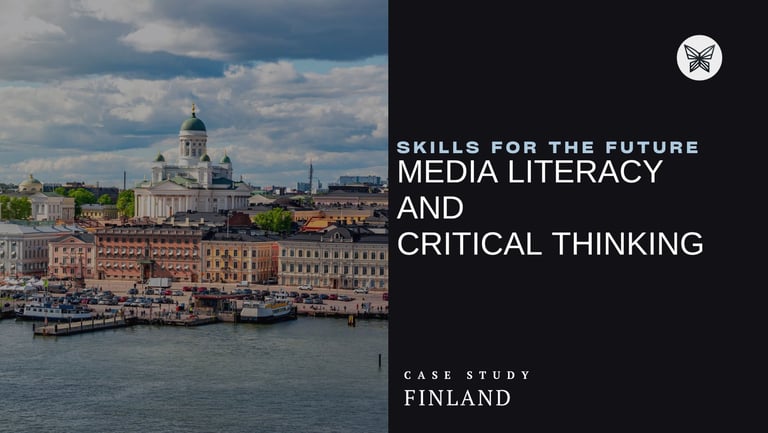Finland’s Media Literacy and Digital Education: Leading the Way in the AI-Driven Future
Media Literacy
Finland’s Media Literacy and Digital Education: Leading the Way in the AI-Driven Future


October 9, 2024
In today’s world, where we are constantly bombarded with information, distinguishing fact from fiction is more important than ever. Finland has emerged as a global leader in teaching these critical skills through its media literacy and digital education programs. Recently featured by CBS News, In Finland, classes in recognizing fake news, disinformation Finland’s approach has gained international recognition, setting an example for countries dealing with the challenges of fake news, disinformation, and the digital complexities of modern life.
Finland’s Approach to Media Literacy
In Finland, media literacy is integrated into the national curriculum from early childhood through adulthood. Rather than being a separate subject, it is embedded into various areas like language arts, social studies, history, and health education. This helps students develop critical thinking skills early on, teaching them to evaluate sources, distinguish fact from fiction, and recognize biases.
Teachers are provided with strong support, including tools and resources to bring media literacy to life in their classrooms. By making media literacy part of everyday education, Finland equips its citizens with the skills they need to navigate today’s complex information landscape, fostering not just smarter media consumers, but thoughtful, responsible critical thinkers.
Finland has topped the Media Literacy Index every year since the ranking system was first published in 2017.
Collaboration: A Key to Finland’s Success
One of Finland’s greatest strengths in media literacy is its collaborative approach. The country has created a dynamic ecosystem that brings together a wide range of stakeholders, including:
Government Agencies: The Ministry of Education and Culture sets national policies and provides funding, while the National Audiovisual Institute (KAVI) coordinates initiatives, develops resources, and monitors progress.
Educational Institutions: Universities and teacher training programs ensure educators are well-prepared to teach media literacy.
Civil Society: NGOs like the Mannerheim League for Child Welfare advocate for media literacy and run programs for children and youth.
Media Organizations: Finnish media companies promote responsible media practices and participate in educational initiatives.
Libraries: Public libraries offer resources, technology, and programs to enhance digital literacy.
Parents and Families: Finland encourages parents to play an active role in supporting their children’s media literacy at home.
This collaborative model allows for the sharing of knowledge and resources, ensuring media literacy initiatives have a broad and lasting impact nationwide. Finland’s media literacy policy highlights the importance of partnerships between government, educators, and society to create a media-literate population.
Lifelong Learning: Adapting to a Changing Digital Landscape
Finland understands that media literacy is not a one-time lesson but an ongoing process. As digital technologies rapidly evolve, so must media literacy skills. To keep citizens engaged in critical media consumption, Finland promotes continuous learning through workshops, public events, and campaigns. This national effort ensures that both adults and children stay agile in their media skills, ready to adapt to the ever-changing digital landscape.
Digitalization in Education: Preparing for the AI-Driven Future
Beyond media literacy, Finland’s broader digitalization strategy aims to position the country as a leader in sustainable digital education by 2027. This vision goes beyond the classroom, offering lifelong learning opportunities and digital tools that support students, teachers, and lifelong learners at every stage of their journey.
Key components of Finland’s digital education vision include:
Equal Access to Learning: Digital tools provide equal access to education, offering personalized learning paths and helping to reduce regional disparities.
Continuous Digital Skill Development: From early childhood through adulthood, students are equipped with the digital skills necessary to adapt to an AI-driven world.
Data-Driven Decision Making: Finland’s digital education policies focus on using data to improve educational systems, ensuring resources are used efficiently and fairly.
Lessons for the Global Stage
Finland's approach offers valuable lessons for other countries looking to prepare their citizens for the digital age. Key takeaways include:
Early and Integrated Education: Embedding media literacy and digital skills into the curriculum from an early age equips students with the critical tools to navigate today's complex information landscape.
Collaboration Across Sectors: Bringing together a wide range of stakeholders—from government and educational institutions to media organizations and civil society—ensures that media literacy initiatives are robust and comprehensive.
Lifelong Learning: Media literacy and digital skills must continually evolve alongside technology, and providing opportunities for ongoing learning is essential to keeping citizens prepared.
A Model for the Future
As countries around the world face the challenges of disinformation, AI, and an increasingly complex digital landscape, Finland’s holistic approach to media literacy and digital education stands out as a model to follow. By fostering critical thinking, promoting collaboration, and encouraging lifelong learning, Finland is not only preparing its citizens for today’s challenges but also empowering them for the AI-driven future.
Best, Tarja
Let’s Shape the Future Together
My goal with this journal is to inspire leaders to navigate AI transformation with wisdom, courage, and leadership that keeps people at the core. Thank you for being part of this journey. If these insights resonate, I invite you to share, because the future of leadership isn’t built alone. Let’s create it together.

